The Effect of Pre-Filter and Main-Filter Media Matching on the Performance of an Ultra-High-Efficiency Two-Stage Filtration System
Abstract
1. Introduction
2. Materials and Methods
2.1. Experimental Design and Materials
2.1.1. Experimental Design
2.1.2. Filter Media
2.2. Loading Test Procedure
2.3. Evaluation Parameters of Dust Holding Performance of Two-Stage Filtration Systems
3. Results and Discussion
3.1. Influence of Pre-Filter Grade on the Dust Holding Performance of Two-Stage Filtration Systems
3.2. Influence of Main-Filter Type on the Dust Holding Performance of Two-Stage Filtration Systems
4. Conclusions
Author Contributions
Funding
Data Availability Statement
Conflicts of Interest
References
- Zhang, J.; Chen, Z.; Shan, D.; Wu, Y.; Zhao, Y.; Li, C.; Shu, Y.; Linghu, X.; Wang, B. Adverse Effects of Exposure to Fine Particles and Ultrafine Particles in the Environment on Different Organs of Organisms. J. Environ. Sci. 2024, 135, 449–473. [Google Scholar] [CrossRef]
- Groma, V.; Alföldy, B.; Börcsök, E.; Czömpöly, O.; Füri, P.; Horváthné Kéri, A.; Kovács, G.; Török, S.; Osán, J. Sources and Health Effects of Fine and Ultrafine Aerosol Particles in an Urban Environment. Atmos. Pollut. Res. 2022, 13, 101302. [Google Scholar] [CrossRef]
- Chauhan, B.V.S.; Corada, K.; Young, C.; Smallbone, K.L.; Wyche, K.P. Review on Sampling Methods and Health Impacts of Fine (PM2.5, ≤2.5 Μm) and Ultrafine (UFP, PM0.1, ≤0.1 Μm) Particles. Atmosphere 2024, 15, 572. [Google Scholar] [CrossRef]
- Daiber, A.; Kuntic, M.; Hahad, O.; Delogu, L.G.; Rohrbach, S.; Di Lisa, F.; Schulz, R.; Münzel, T. Effects of Air Pollution Particles (Ultrafine and Fine Particulate Matter) on Mitochondrial Function and Oxidative Stress—Implications for Cardiovascular and Neurodegenerative Diseases. Arch. Biochem. Biophys. 2020, 696, 108662. [Google Scholar] [CrossRef]
- Flood-Garibay, J.A.; Angulo-Molina, A.; Méndez-Rojas, M.Á. Particulate Matter and Ultrafine Particles in Urban Air Pollution and Their Effect on the Nervous System. Environ. Sci. Process. Impacts 2023, 25, 704–726. [Google Scholar] [CrossRef]
- Vaishnav, D.; Patel, B. Laparoscopic Gastrointestinal Surgery During COVID-19 Pandemic: Single-Center Experience. J. Laparoendosc. Adv. Surg. Tech. 2021, 31, 455–457. [Google Scholar] [CrossRef]
- Searle, T.; Ali, F.R.; Al-Niaimi, F. Surgical Smoke Generated by Electrocautery. Lasers Med. Sci. 2021, 36, 1555–1556. [Google Scholar] [CrossRef]
- Zhou, B.; Wu, X.; Chen, L.; Fan, J.-Q.; Zhu, L. Modeling the Performance of Air Filters for Cleanrooms Using Lattice Boltzmann Method. Build. Simul. 2021, 14, 317–324. [Google Scholar] [CrossRef]
- Roberts, E.; Ghosh, S.; Pourdeyhimi, B. Process–Structure–Property Relationship of Roping in Meltblown Nonwovens. J. Text. Inst. 2023, 114, 289–302. [Google Scholar] [CrossRef]
- Park, S.-H.; Jo, J.-H.; Kim, E.-J. Data-Driven Models for Estimating Dust Loading Levels of ERV HEPA Filters. Sustainability 2021, 13, 13643. [Google Scholar] [CrossRef]
- Siegel, J.E.; Bhattacharyya, R.; Kumar, S.; Sarma, S.E. Air Filter Particulate Loading Detection Using Smartphone Audio and Optimized Ensemble Classification. Eng. Appl. Artif. Intell. 2017, 66, 104–112. [Google Scholar] [CrossRef]
- Moon, S.M.; Lee, S.; Min, H.; Park, S.; Yoon, S.; Choi, J.H.; Yoon, S.M.; Jung, B.; Im, T.; Jeong, C.; et al. Design and Integration of a Gas Sensor Module That Indicates the End of Service Life of a Gas Mask Canister. Adv Mater. Technol. 2022, 7, 2100711. [Google Scholar] [CrossRef]
- Synák, F.; Kalašová, A.; Synák, J. Air Filter and Selected Vehicle Characteristics. Sustainability 2020, 12, 9326. [Google Scholar] [CrossRef]
- Dziubak, T.; Bąkała, L.; Dziubak, S.D.; Sybilski, K.; Tomaszewski, M. Experimental Research of Fibrous Materials for Two-Stage Filtration of the Intake Air of Internal Combustion Engines. Materials 2021, 14, 7166. [Google Scholar] [CrossRef] [PubMed]
- Dziubak, T. Performance Characteristics of Air Intake Pleated Panel Filters for Internal Combustion Engines in a Two-Stage Configuration. Aerosol Sci. Technol. 2018, 52, 1293–1307. [Google Scholar] [CrossRef]
- Dziubak, T. Experimental Testing of Filter Materials for Two-Stage Inlet Air Systems of Internal Combustion Engines. Energies 2024, 17, 2462. [Google Scholar] [CrossRef]
- Okhotnikov, M.V.; Nusenkis, A.A.; Maksudov, D.V. Two-Level Electrostatic Filter for Fine Cleaning. In IOP Conference Series: Earth and Environmental Science; IOP Publishing: Bristol, UK, 2019; Volume 272, p. 032082. [Google Scholar] [CrossRef]
- Jeong, S.-G.; Kim, M.; Lee, T.; Lee, J. Application of Pre-Filter System for Reducing Indoor PM2.5 Concentrations under Different Relative Humidity Levels. Build. Environ. 2021, 192, 107631. [Google Scholar] [CrossRef]
- Deuber, F.; Mousavi, S.; Federer, L.; Hofer, M.; Adlhart, C. Exploration of Ultralight Nanofiber Aerogels as Particle Filters: Capacity and Efficiency. ACS Appl. Mater. Interfaces 2018, 10, 9069–9076. [Google Scholar] [CrossRef]
- Li, Z.; Kang, W.; Zhao, H.; Hu, M.; Ju, J.; Deng, N.; Cheng, B. Fabrication of a Polyvinylidene Fluoride Tree-like Nanofiber Web for Ultra High Performance Air Filtration. RSC Adv. 2016, 6, 91243–91249. [Google Scholar] [CrossRef]
- Hu, M.; Wang, Y.; Yan, Z.; Zhao, G.; Zhao, Y.; Xia, L.; Cheng, B.; Di, Y.; Zhuang, X. Hierarchical Dual-Nanonet of Polymer Nanofibers and Supramolecular Nanofibrils for Air Filtration with a High Filtration Efficiency, Low Air Resistance and High Moisture Permeation. J. Mater. Chem. A 2021, 9, 14093–14100. [Google Scholar] [CrossRef]
- Wang, L.-Y.; Yong, W.F.; Yu, L.E.; Chung, T.-S. Design of High Efficiency PVDF-PEG Hollow Fibers for Air Filtration of Ultrafine Particles. J. Membr. Sci. 2017, 535, 342–349. [Google Scholar] [CrossRef]
- Zulfi, A.; Munir, M.M.; Hapidin, D.A.; Rajak, A.; Edikresnha, D.; Iskandar, F.; Khairurrijal, K. Air Filtration Media from Electrospun Waste High-Impact Polystyrene Fiber Membrane. Mater. Res. Express 2018, 5, 035049. [Google Scholar] [CrossRef]
- Tian, X.; Ou, Q.; Lu, Y.; Liu, J.; Liang, Y.; Pui, D.Y.H.; Yi, H. Influence of Oil Content on Particle Loading Characteristics of a Two-Stage Filtration System. Atmosphere 2023, 14, 551. [Google Scholar] [CrossRef]
- Tian, X.; Ou, Q.; Pei, C.; Li, Z.; Liu, J.; Liang, Y.; Pui, D.Y.H. Effect of Main-Stage Filter Media Selection on the Loading Performance of a Two-Stage Filtration System. Build. Environ. 2021, 195, 107745. [Google Scholar] [CrossRef]
- Akduman, C.; Demirel, V.; Tezcan, F. Filter Life Comparison of Different Levels of Nanofiber Coated Cleanable-surface Filter for Gas Turbine. J. Appl. Polym. Sci. 2021, 138, 50820. [Google Scholar] [CrossRef]
- Tian, X.; Ou, Q.; Liu, J.; Liang, Y.; Pui, D.Y.H. Influence of Pre-Stage Filter Selection and Face Velocity on the Loading Characteristics of a Two-Stage Filtration System. Sep. Purif. Technol. 2019, 224, 227–236. [Google Scholar] [CrossRef]
- Chen, X.; Mao, Y.; Fan, C.; Wu, Y.; Ge, S.; Ren, Y. Experimental Investigation on Filtration Characteristic with Different Filter Material of Bag Dust Collector for Dust Removal. Int. J. Coal Prep. Util. 2022, 42, 3554–3569. [Google Scholar] [CrossRef]
- Chen, K.; Huang, Y.; Wang, S.; Zhu, Z.; Cheng, H. Experimental Research on Dynamic Filtering Characteristics of Filter Materials for Electrostatic-Fabric Integrated Precipitator. Appl. Sci. 2022, 12, 5824. [Google Scholar] [CrossRef]
- Shen, Y.; Xia, S.; Yao, P.; Hugh Gong, R.; Liu, Q.; Deng, B. Structure Regulation and Properties of Melt-Electrospinning Composite Filter Materials. Fibers Polym. 2017, 18, 1568–1579. [Google Scholar] [CrossRef]
- Penner, T.; Meyer, J.; Kasper, G.; Dittler, A. Impact of Operating Conditions on the Evolution of Droplet Penetration in Oil Mist Filters. Sep. Purif. Technol. 2019, 211, 697–703. [Google Scholar] [CrossRef]
- Tian, X.; Ou, Q.; Liu, J.; Liang, Y.; Pui, D.Y.H. Particle Loading Characteristics of a Two-Stage Filtration System. Sep. Purif. Technol. 2019, 215, 351–359. [Google Scholar] [CrossRef]
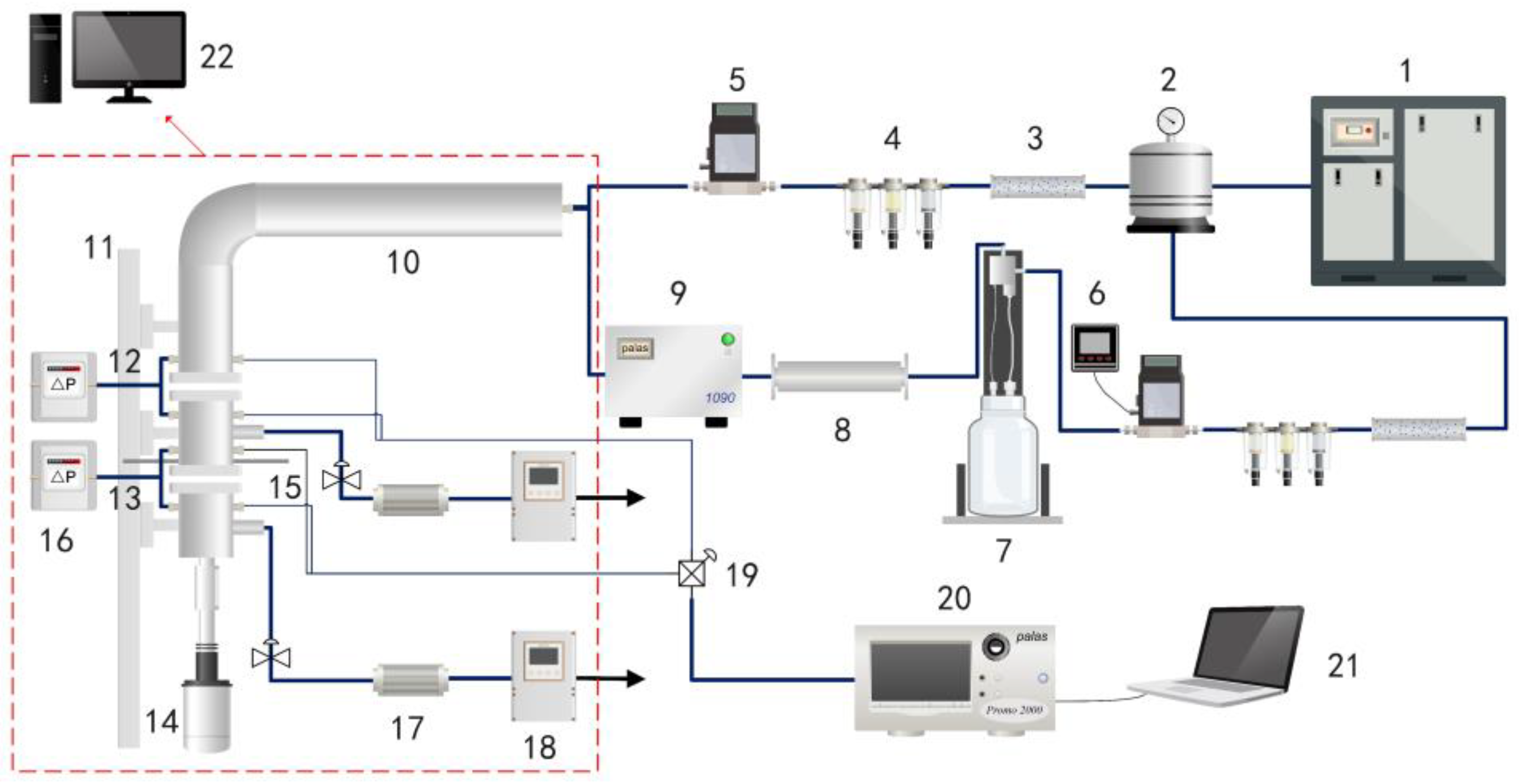
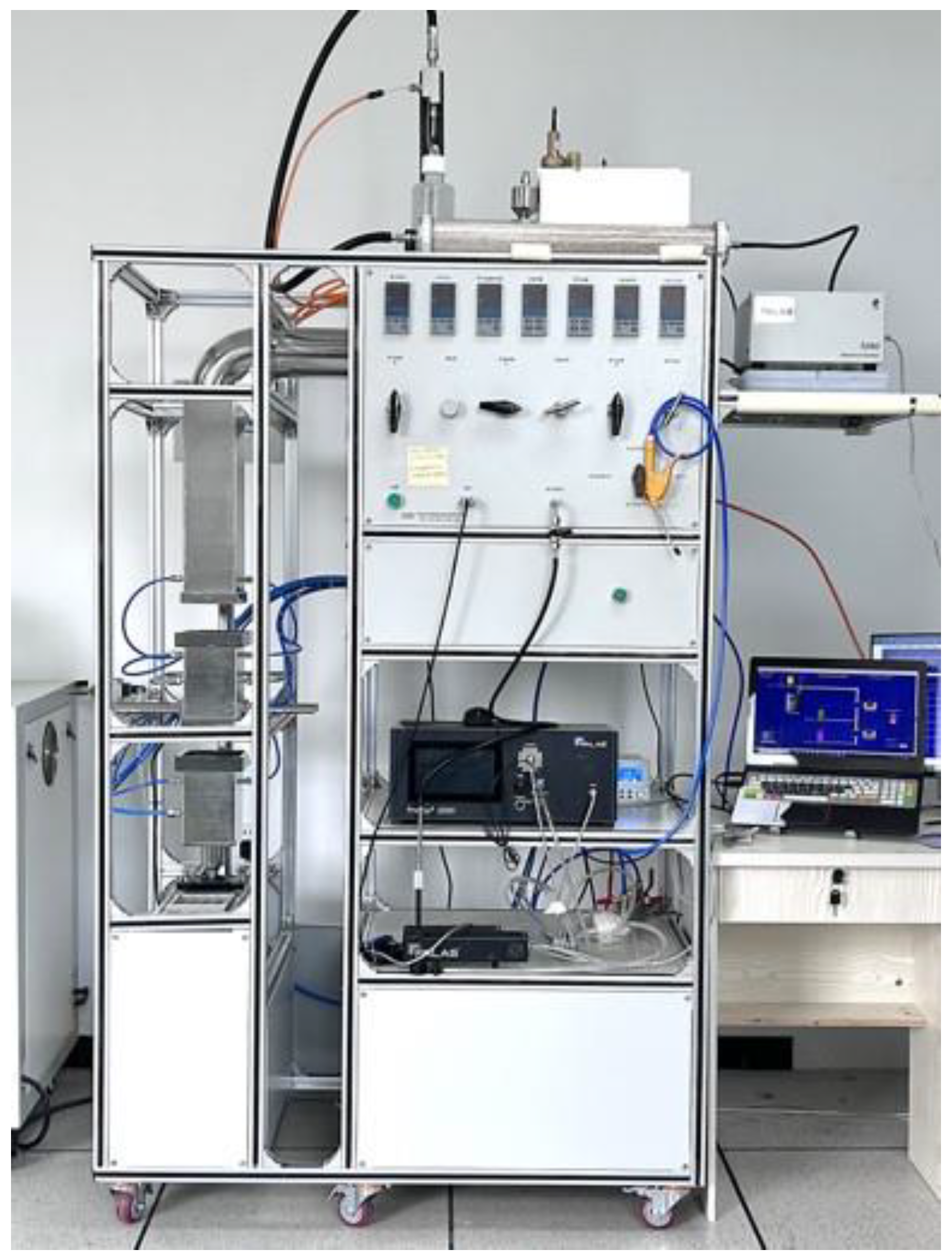
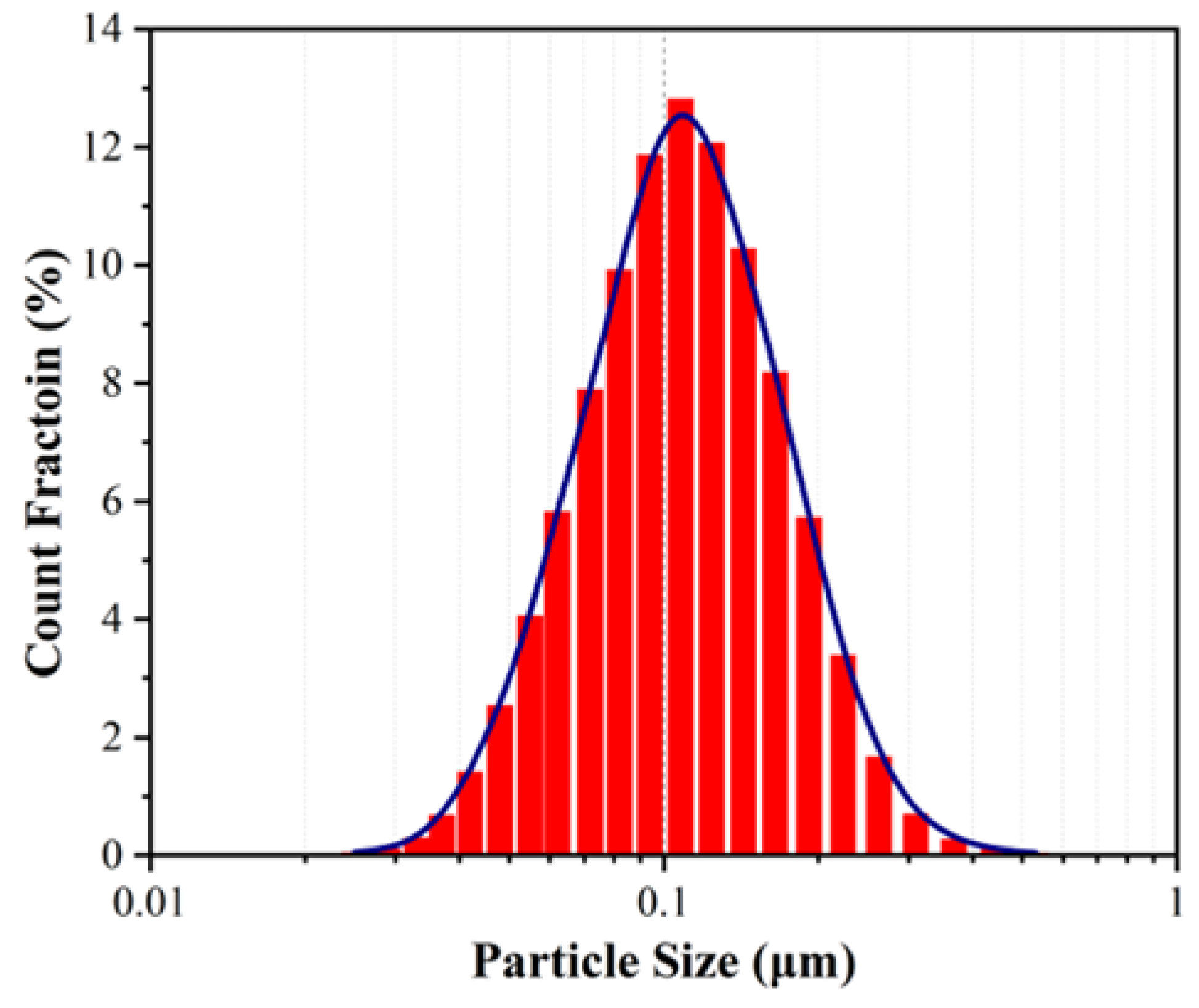




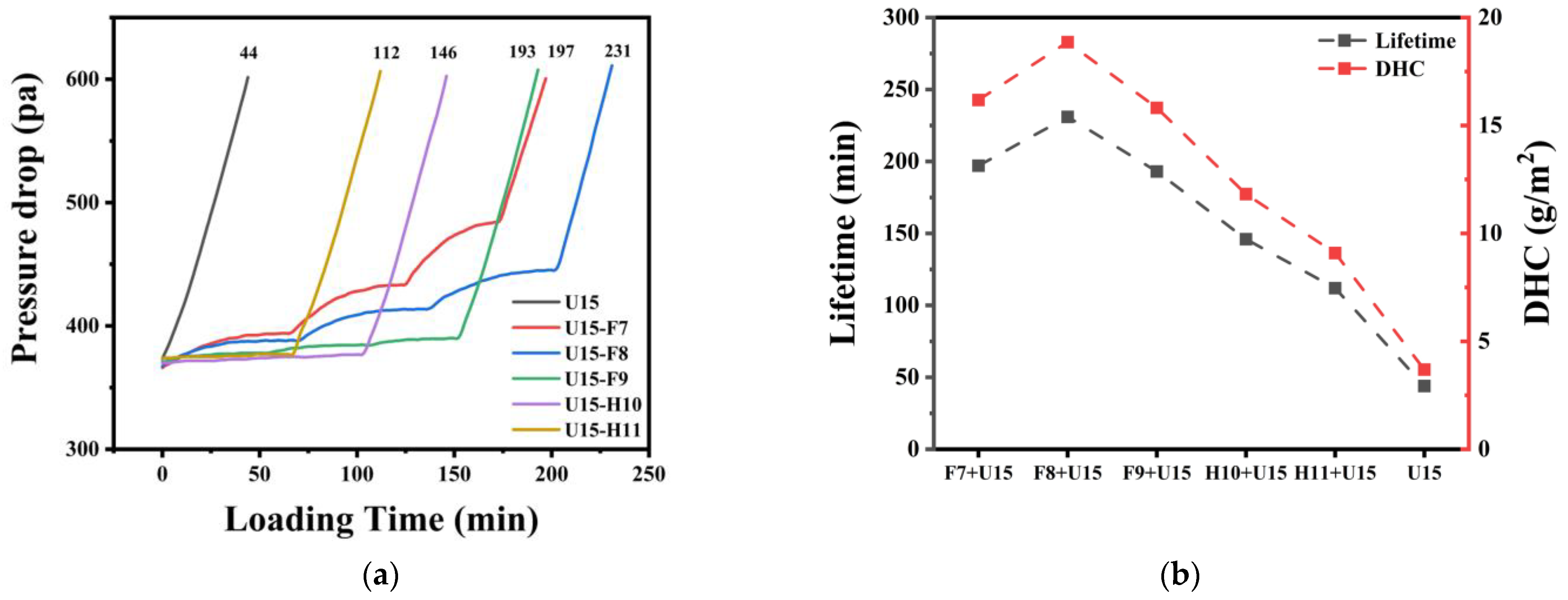
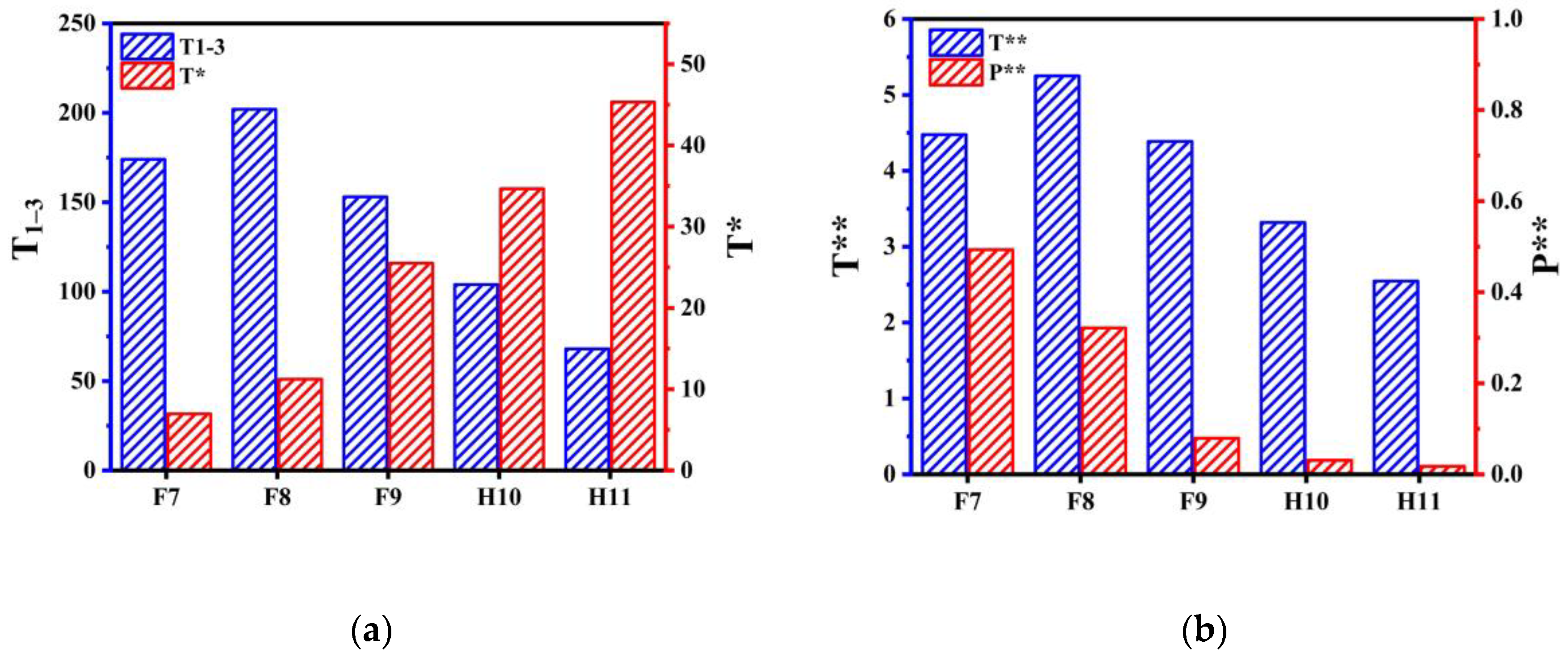
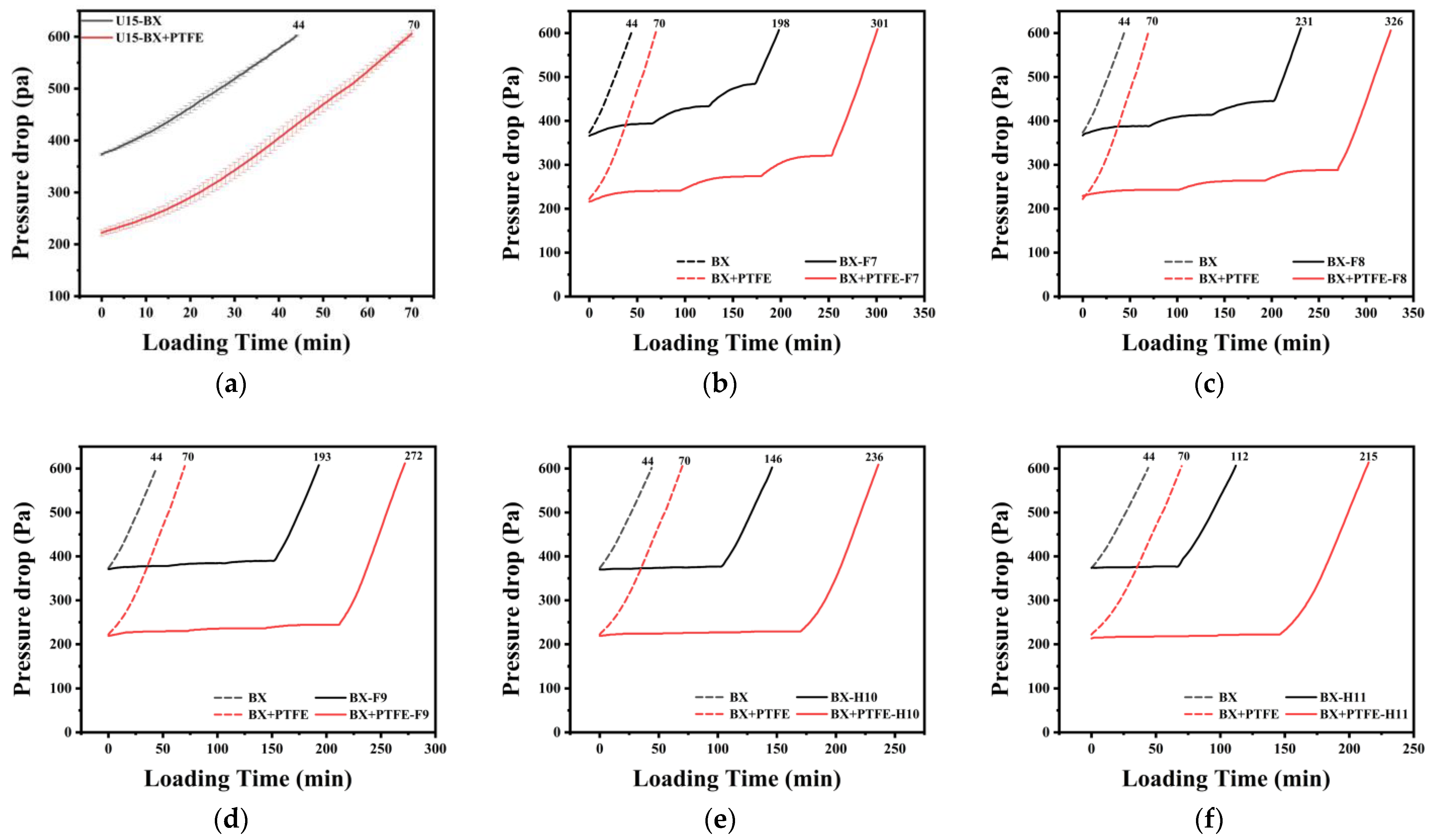

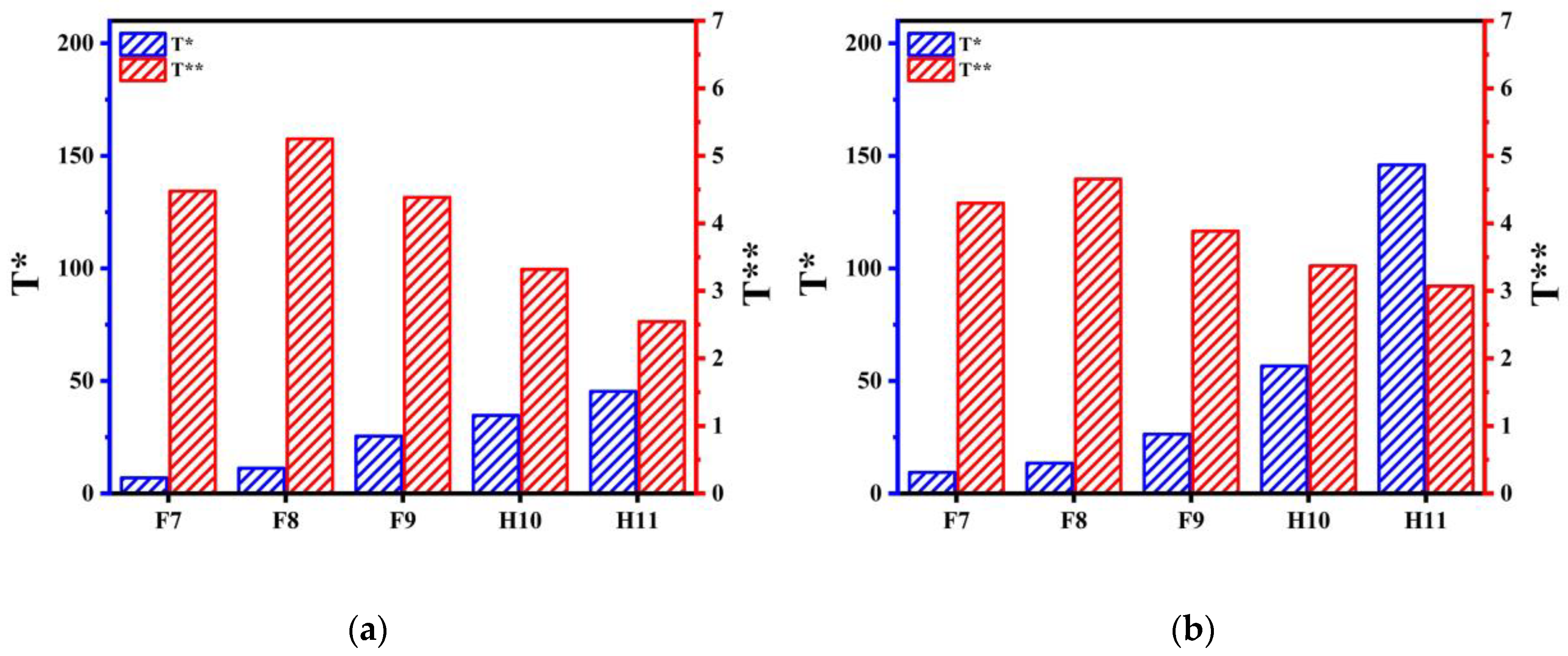
| Filter Samples | Grade | Filter Media Thickness (μm) | Average Weight (g/m2) | Average Pore Size (μm) | Filtration Efficiency (%) | Initial Resistance (Pa) |
|---|---|---|---|---|---|---|
| Pre-filter | F7 | 362 | 77.7 | 9.3 | 55 | 28 |
| F8 | 339 | 75.7 | 9.2 | 65 | 33 | |
| F9 | 324 | 74.7 | 5.8 | 85 | 63 | |
| H10 | 302 | 74.6 | 4.1 | 96 | 107 | |
| H11 | 328 | 78.0 | 3.9 | 99 | 151 | |
| Main-filter | U15(BX) | 348 | 76.6 | 1.8 | 99.9998 | 363 |
| U15(BX + PTFE) | 541 | 138.5 | 1.1 | 99.9996 | 221 |
Disclaimer/Publisher’s Note: The statements, opinions and data contained in all publications are solely those of the individual author(s) and contributor(s) and not of MDPI and/or the editor(s). MDPI and/or the editor(s) disclaim responsibility for any injury to people or property resulting from any ideas, methods, instructions or products referred to in the content. |
© 2025 by the authors. Licensee MDPI, Basel, Switzerland. This article is an open access article distributed under the terms and conditions of the Creative Commons Attribution (CC BY) license (https://creativecommons.org/licenses/by/4.0/).
Share and Cite
Xie, Q.; Kang, J.; Liang, Y.; Wang, H.; Xu, G.; Wang, L.; Tang, M. The Effect of Pre-Filter and Main-Filter Media Matching on the Performance of an Ultra-High-Efficiency Two-Stage Filtration System. Processes 2025, 13, 1075. https://doi.org/10.3390/pr13041075
Xie Q, Kang J, Liang Y, Wang H, Xu G, Wang L, Tang M. The Effect of Pre-Filter and Main-Filter Media Matching on the Performance of an Ultra-High-Efficiency Two-Stage Filtration System. Processes. 2025; 13(4):1075. https://doi.org/10.3390/pr13041075
Chicago/Turabian StyleXie, Qingqing, Jian Kang, Yun Liang, Hao Wang, Guilong Xu, Lingyun Wang, and Min Tang. 2025. "The Effect of Pre-Filter and Main-Filter Media Matching on the Performance of an Ultra-High-Efficiency Two-Stage Filtration System" Processes 13, no. 4: 1075. https://doi.org/10.3390/pr13041075
APA StyleXie, Q., Kang, J., Liang, Y., Wang, H., Xu, G., Wang, L., & Tang, M. (2025). The Effect of Pre-Filter and Main-Filter Media Matching on the Performance of an Ultra-High-Efficiency Two-Stage Filtration System. Processes, 13(4), 1075. https://doi.org/10.3390/pr13041075





